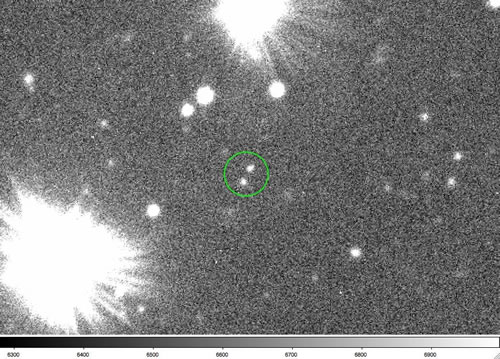[/caption] Astronomers have discovered a pair of small Kuiper Belt Objects that are gravitationally bound to each other. This is somewhat unusual in itself. But even though these two objects are gravitationally connected, they have an enormous separation between them, about 125,000 kilometers (one third the distance from the Earth to the Moon). Astronomers say, as a comparison, this is equivalent to a pair of baseballs gravitationally "connected" and orbiting each other at a distance of 200 kilometers!
The extreme binary, 2001 QW322, orbits at 43 astronomical units or about 6.5 billion kilometers from the Sun. The pair was originally discovered in August 2001 with the Canada-France-Hawai'i Telescope. Since then, (from 2002-2007), the pair has been monitored closely using 8-meter-class telescopes (Gemini North, Gemini South and the European Southern Observatory's Very Large Telescope) to obtain high precision photometric observations of the faint double system.
In the above images, their separation was 1.8 arcseconds. Their radii are about 50 kilometers. There are on the order of about a billion additional Kuiper Belt Objects in our solar system with Pluto and Charon being among the largest members of this important group of minor planets. These small icy bodies move in low eccentricity and low inclination orbits beyond Neptune, extending possibly as far as 1,000 times the distance from the Earth to the Sun.
Most Kuiper Belt Objects are single objects. The advent of adaptive optics and various survey techniques has created a surge in the discovery of binaries in the main asteroid and Kuiper belts. Astronomers say 2001 QW322 clearly stands out as the widest orbit, near-equal mass binary of the solar system.
Source:
Gemini Observatory
 Universe Today
Universe Today
